Beginner’s Guide To Music Theory Part 8: Chord Progressions Vol. 2
Author: Jonas Schoen-Philbert
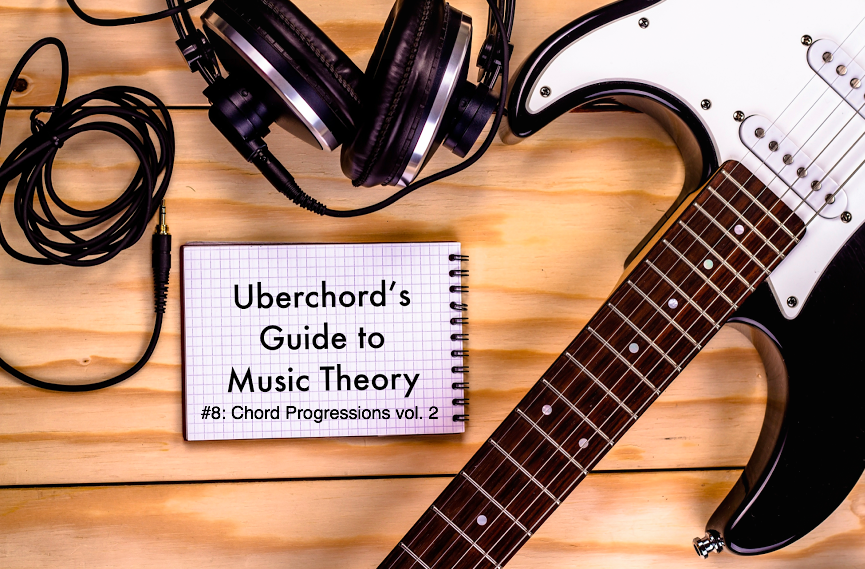
Welcome back! If this is your first visit and you’ve missed our previous music theory lessons, we recommend getting familiar with the material before jumping into chord progressions:
- Music Theory #1: he Major Scale
- Music Theory #2: Intervals
- Music Theory #3: Chords
- Music Theory #4: The Circle of Fifths
- Music Theory #5: Music Modes
- Music Theory #6: Chord Inversions
- Music Theory #7: Chord progressions Vol. 1
Having learnt about the degrees, parallel chords and main harmonic functions in major and minor, we will now move another step forward. In this post we will be exploring more chords which can add colour to a chord progression.
Table of Contents
Secondary Dominant Chords
One of the most important movements in a chord progression is the dominant to tonic. We have already covered this in a previous post as well as voice leading; the way each note moves from one chord to another. So far we have only applied this in situations where the dominant is the 5th degree and the tonic is the 1st degree, such as in C where we go from G7 to C or C min.
You can also incorporate the dominant chord to any of the diatonic chords of a key. Simply pick any chord built on the 2nd to 5th degree and move up a perfect 5th, which then will be the root of the dominant chord. This may sound confusing, so take a look at this list of diatonic chords in C and the dominant chord to each of them:
If you look at the secondary dominants you will find that most of them have the same root notes as the diatonic degrees. The only exception is F#7, the secondary dominant to B dim. Comparing the diatonic degree chords to the the secondary dominants with the same root looks like this:
- 1st degree C -> C7 (dominant to F)
- 2nd degree Dmin -> D7 (dominant to G)
- 3rd degree Emin -> E7 (dominant to A min)
- 4th degree Amin -> A7 (dominant to Dmin)
- 5th degree Bdim -> B7 (dominant to Emin)
But what is the point of all of this?
The secondary dominants occupy diatonic root notes (except one – the dominant to 7th degree; F#7 in our example). The secondary dominant chords also share the Perfect 5th with the diatonic degree chords. This means that they are still quite close to their harmonic environment, but there exists one note which gives ‘spice’ to a chord progression whenever you use a secondary dominant.
How Do We Use Secondary Dominants?
Due to the common root note in many cases you can replace the diatonic chord with a secondary dominant. Easiest example:
C – Amin – Dmin – G7 (all diatonic chords) can turn into:
C – A7 – D7 – G7 (replacing Amin and Dmin with A7 and D7)
C – A7 – Dmin – G7 (replacing only Amin with A7)
C – Amin – D7 – G7 (replacing only Dmin with D7)
This works best if the roots move in 4ths up or 5ths down, which leads to a chain of dominant chords. The longest chain that can be created with just diatonic root notes is:
C – B7 – E7 – A7 – D7 – G7 – C
The chain resolves back to the tonic C. You could even replace the C with C7 going to F. If you try this you will find that from F, the chord progression seems to ‘beg’ to be resolved by a final C chord, as this chain of dominants creates a lot of tension.
In minor keys this doesn’t work all that easily because of the third degree. In major keys this is almost at the beginning of the dominant chain but in minor it is a half note lower, so that jumping in 4ths up / 5ths down will not lead into the tonic.
Moving in dominant chains in minor is nevertheless common and may look like this:
Amin – A7 – D7 – G7 – C7 – F7 – B7 – E7 – Amin
Tritone Substitutes
This deserves its own separate article but I’d like to briefly mention them here: tritone substitutes. Put quite simply, you can replace the bass note of any (yes, any!) dominant chord with a tritone (up or down makes no difference, since the tritone splits the octave in the exact middle).
Let us introduce a habit that makes dealing with dominant chords much easier: let us play them with the root, the 3rd and the 7th, OMITTING the 5th. Here we have a progression with D7, G7 and C7. Let’s assume C is the tonic, making D7 the double dominant (dominant to the dominant), G7 the dominant and C7 the tonic. Or in degrees: II7 – V7 – I7 (2nd, 5th and 1st degrees).
The upper voices move down chromatically as they always do in dominant chains. The 3rd of one dominant chord moves down a half note to the 7th of the next dominant chord and so on. Likewise, the 7th of a dominant moves down chromatically into the third of the next dominant chord. If you replace the root note of a dominant chord by its tritone, the main and most important notes (the 3rd and 7th) stay the same except that the 7th will be the 3rd and the 3rd will be the 7th. You can easily see that, if you compare the G7 chord with the Db7 chord in the example above.
If we apply this to the long chain of dominant chords (see above) we get a complete chromatic movement:
C – B7 – E7 – A7 – D7 – G7 – C
C – F7 – E7 – Eb7 – D7 – Db7 – C or
C – B7 – Bb7 – A7 – Ab7 – G7 – C
Modal Interchange
There are a few very beautiful progressions that can easily be understood by using something we call Modal Interchange. In this, diatonic chords are ‘borrowed’ from a different mode of the same tonic. Although this sounds sophisticated, it really isn’t. Using an F minor chord sounds great in C major, and we consider it the 4th degree of C minor. We’re then borrowing from the minor scale, even though our key is in fact C major. There is a few very common chord progression that might be explained with modal interchange. Fmin in C is one, Fmin – Bb7 – C is a variation of it. Ab – Bb – C is one more that is used very often, Ab and Bb both “borrowed” from a virtual Cmin tonic:
If we assemble everything we have learned about chord progressions so far, we have become familiar with:
- Diatonic chords (the degrees)
- Secondary dominants
- Tritone substitutes to all dominants (also the secondary ones)
There’s plenty more to learn with all the links in this article. However if you’re in the mood for something other than theory, then our blog can help you with gear, beginner/intermediate guitar technique, as well as songwriting and making chord progressions. Some of our most recent articles include our guitar chord finder app, eb guitar chords, and chords and lyrics to house of the rising sun.
Happy practicing!
Here’s some other Music Theory Lessons you might enjoy:


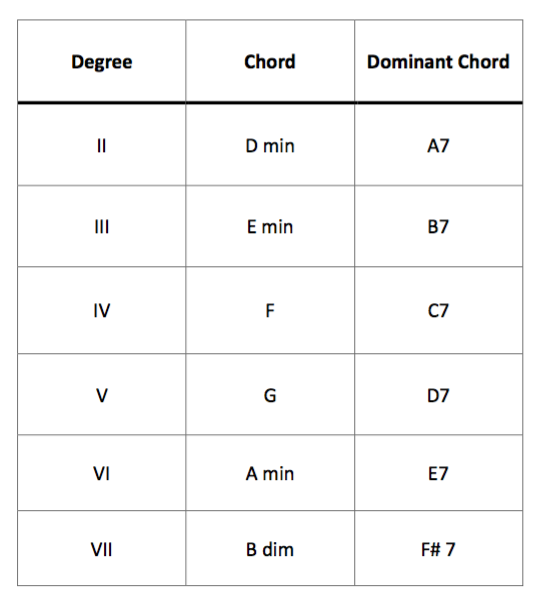
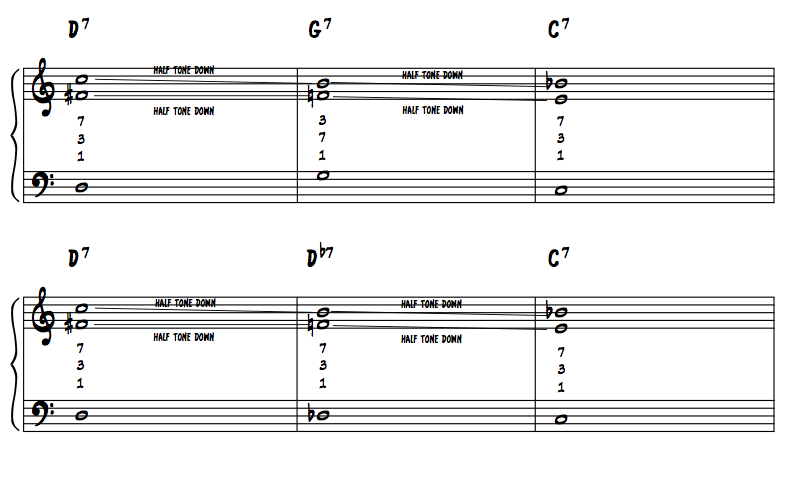






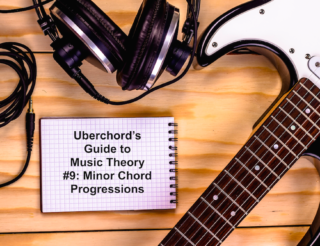
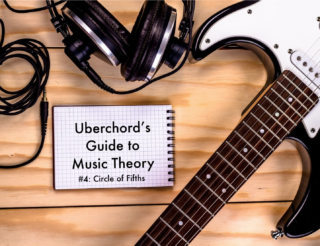


Wow..!! its really help though. I was dreaming about this if one day be a rock star in playing guitar.
I desperately need of having more of these especially fingering skills how to play electric guitar.
Could you be kind enough to send me through my email for free lesson please.